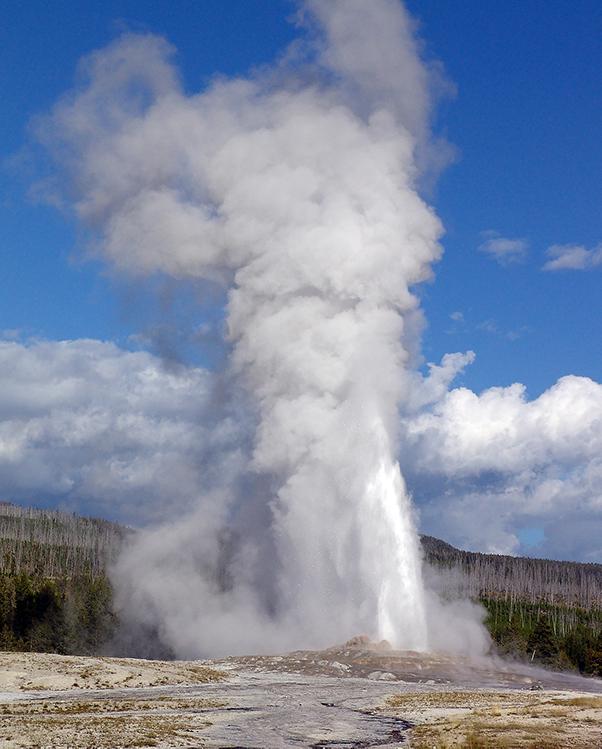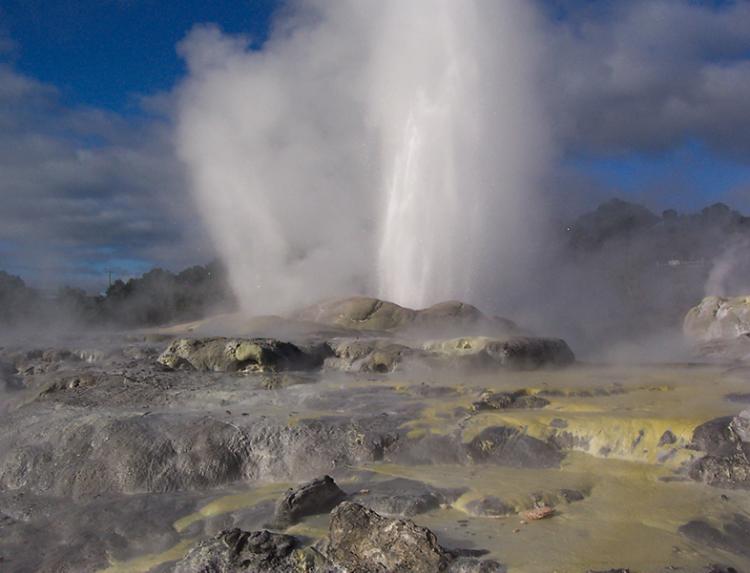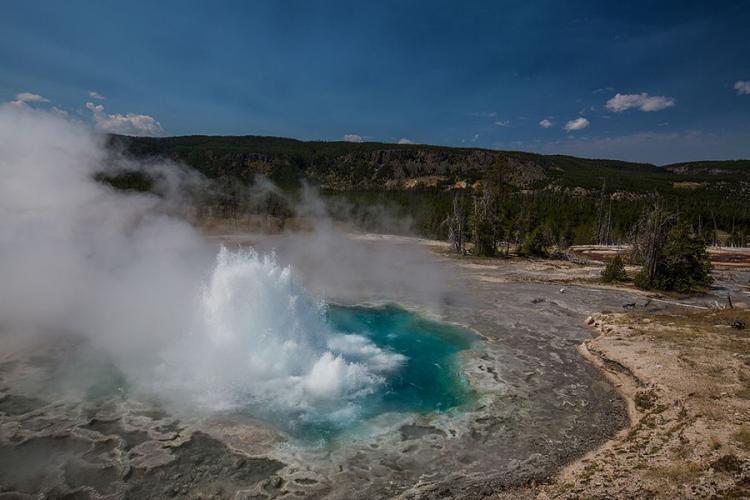Thar she blows: The what, why and where of geysers
Scientists make progress in mapping the hidden force behind the watery eruptions
Support sound science and smart stories
Help us make scientific knowledge accessible to all
Donate today
If you’ve been to Yellowstone National Park, you’ve surely seen one of the world’s most famous geysers. About every hour to an hour and a half, Old Faithful shoots a towering plume of hot water and steam into the air. Crowds of camera-laden tourists swarm at a safe distance — the water can be a blistering 200 degrees Fahrenheit (about 95 degrees Celsius) and the steam more than 350 degrees F (175 degrees C).
Scientists, too, have flocked to Old Faithful. Its reliable blasts provide a natural laboratory for studying how boiling water jets out of the ground and into the air. In a memoir in the 2017 Annual Review of Earth and Planetary Sciences, geophysicist Susan Kieffer recalls how an Ansel Adams photograph of Old Faithful inspired her to pack her 9-year-old son into a Volkswagen camper and set off for Yellowstone in 1976. In a month of filming Old Faithful, she set the stage for the modern understanding of how heated water and steam, interacting in underground chambers, power the geyser’s eruptions.

Perhaps the most famous geyser at Yellowstone National Park, Old Faithful sends thousands of gallons of boiling water and steam between 100 and 200 feet skyward with each eruption. Its eruptions are frequent, but nothing to set your watch by, with the time between the brief bursts swinging between one hour and nearly two.
CREDIT: TOM SIEGFRIED (CC-BY-SA)
Today, researchers have studied not only Yellowstone’s geysers — which account for about half of the world’s total — but hundreds of others around the world. They include groupings of geysers in such places as Iceland, Russia’s Valley of the Geysers and New Zealand’s North Island. Scientists have dumped colored dye down the throat of geysers to see how long it takes the color to clear, and peppered the nearby ground with seismometers to listen for underground rumblings before each blast.
Such studies are now revealing the complex physics behind geysers, two geoscientists write in the 2017 Annual Review of Earth and Planetary Sciences.
It takes a rare combination of underground cavities and hot springs, powered by geothermal energy, to create these stunning natural fountains, say Shaul Hurwitz of the US Geological Survey in Menlo Park, California, and Michael Manga of the University of California, Berkeley. Here’s a look at what drives these rare, fascinating eruptions, and what researchers are learning about why eruptions end, change their timing and sometimes disappear altogether. Geysers could also provide clues to how big, dangerous volcanoes operate — and even tell us about the planetary processes on other worlds.
What is a geyser?
A geyser is any hot spring that occasionally erupts a combination of turbulent water and steam. That means geysers require constant replenishment of both heat and water. So most are found in volcanically active areas, which supply heat from below, and in places with lots of rain or snowfall to provide the water. Many geysers appear in groups known as geyser fields, where the eruption of one particular geyser may affect the behavior of nearby ones — making them more erratic, for example, or less frequent.
Geysers also require underground cavities where water, steam and pressure can accumulate. Without such voids, water would simply burble up quietly and consistently in a hot spring. The buried voids allow fluid and gas to build up over time, setting up the complex interplay between pressure and temperature that results in a sudden, turbulent discharge.
Boiling below: The underground plumbing of geysers varies dramatically from place to place, as in this comparison from New Zealand (left) and Wyoming (right). All, however, are supplied by water recharged during rainfall, and by a source of deep geothermal heat that raises the water’s temperature and transforms it explosively into steam and a spout of water. Fumaroles, in contrast, belch out only steam and other gases; hot spring pools are heated by geothermal energy but lack the fizz of geysers. (Not to scale).
CREDIT: S. HURWITZ AND M. MANGA / ANNUAL REVIEW OF EARTH AND PLANETARY SCIENCES 2017. ADAPTED BY DOUG BECKNER / KNOWABLE MAGAZINE
Most geysers reach heights of a few feet to tens of feet. Yellowstone’s Steamboat geyser — the biggest in the world — regularly erupts to a height of around 375 feet.
What makes a geyser erupt?
Water percolating down from above is warmed by geothermal heat from below, forming pressurized steam in an underground cavity. The high pressure causes the water to become superheated above its usual boiling point of 212 degrees F (100 degrees C). When the water gets a chance to expand, for instance by leaking out of the geyser opening, the pressure immediately drops, allowing the superhot water to boil. Almost immediately the deep water transforms into steam, which expands rapidly and violently and pushes the entire water-steam mixture into the air as an eruption.
German chemist Robert Bunsen (of Bunsen-burner fame) discovered this relationship between pressure and boiling points in 1846 after putting a thermometer down Geysir, the geyser in southern Iceland from which the phenomenon gets its name, meaning “to spout” or “to rush forth.”
Since then, scientists have conducted other experiments, such as putting dye in Old Faithful to trace how long the color would last through a series of eruptions. That work, in 1963, showed that it took more than 24 eruptions for the geyser to clear, suggesting that Old Faithful’s underground cavity contained much more fluid than the amount ejected in each blast.
In more recent research, Manga and his colleagues have worked at a geyser field in Chile known as El Tatio, about 14,000 feet high in the Atacama Desert. At such high elevations, water boils at a lower temperature, so it takes less geothermal heat to produce a geyser. Tourists arrive at dawn to watch the wispy steam plumes condensing in the frigid air and, when they’re lucky, a spectacular eruption against the mountainous background.

El Tatio geyser field (pictured) lies high in the Andes Mountains and is home to some 80 active geysers.
CREDIT: DIEGO DELSO, DELSO.PHOTO (CC-BY-SA)
Manga’s team installed instruments to measure pressure and temperature at different depths in the geyser field, as well as seismic activity and shifting of the ground. “We can confirm that Bunsen’s ideas are correct — that eruptions begin when boiling begins at the top of the water column,” says Manga. “And we can also answer questions like, why do eruptions end?” The answer, his group found over the last couple of years, is that geysers end when they run out of steam that comes from greater depths.
Geothermal exploration has killed many geyser fields in places like Nevada and New Zealand. By tapping into underground sources of heat — mostly from radioactive decay of elements in the planet’s crust — to extract energy, companies have removed the warmth that fueled geysers there.

The many geysers in New Zealand’s Whakarewarewa Geothermal Valley spring from a common fissure deep in the Earth. Geyser activity in the valley, which has been home to a Maori community for more than 500 years, declined last century. In the 1980s, filling water wells closest to the geysers revived some but not all of the valley’s geysers.
CREDIT: WIKIMEDIA COMMONS
Why is geyser behavior so hard to predict?
Some geysers are as regular as clockwork, whereas others are erratic. The key to predicting eruptions is to watch a geyser for a very long time. In Yellowstone, park rangers and amateurs have gathered records at Old Faithful and elsewhere stretching back decades.
At the less-scrutinized El Tatio, Manga’s team studied a big geyser called El Jefe. In 2012 it erupted on average every 132 seconds over the week the researchers were there. In 2014, when the scientists returned, it was erupting an average of every 105 seconds. Today it is completely dead.
Geysers are ephemeral. Over time, geysers may change their activity because of the way heat and water flow through the ground. The water usually carries silica-rich minerals, which precipitate out onto the ground as slick mounds or terraces around the eruption point. Those minerals may also gunk up the underground conduits through which the water is flowing, causing some geysers to shut down and others to rejuvenate.
Weather may tweak a geyser’s clockwork. Some, such as Yellowstone’s Daisy Geyser, are covered by big pools of water; in cold, rainy weather it takes longer for the surface water to reach boiling and the geyser to erupt. Wind can also change eruption frequency, since strong winds cool the surface waters and delay eruptions.

Between eruptions, geysers like Artemisia in Yellowstone National Park look like hot springs. As boiling begins, water often overflows the pool’s edges.
CREDIT: REFMARINO (CC-BY-SA 4.0)
Earthquakes can also change the frequency of geyser eruptions, even from very far away. In 2002, a magnitude-7.9 earthquake in Alaska changed the behavior of some of the Yellowstone geysers, more than 1,900 miles away. Within hours of the quake, several small hot springs burst into brand-new temporary fountains, while other more-established geysers started erupting more or less often. “Presumably the passage of seismic waves changed the pathways through which fluids were moving,” says Manga. “Funny things can happen in the Earth.”
Are geysers volcanoes?
No. Geysers erupt water and steam rather than the rock and ash that comes out of a volcano. Geysers are also physically much smaller than volcanoes, and erupt more frequently. Still, many of the processes are similar, and measurements of geysers can help scientists understand some aspects of volcanoes, Manga says. For instance, studying how big an underground cavity has to be before a geyser forms could help illuminate the relationship between underground magma chambers and volcanic eruptions.
That makes geysers small natural laboratories for exploring eruptive processes, like those at volcanoes. Seismologists have tracked tiny rumblings in the ground that emanate from geysers before they let loose in a blast. The tremors probably come from bubbles rapidly growing and collapsing within the underground reservoir. In recent years, scientists have documented small seismic rumblings they call “preplay,” which often indicate that a larger eruption is on the way. The preplay apparently primes the geyser to blow. There is no similar preplay at volcanoes, but understanding the signs that arise before a geyser erupts could help researchers think more creatively about what to look for at volcanoes.
Are there geysers on worlds beyond Earth?
Yes. Neptune’s moon Triton and Saturn’s moon Enceladus both occasionally erupt mixes of solids and gas from their icy surfaces. On Triton, the energy source seems to be sunlight falling on the surface and heating it from above, forming jets possibly made of nitrogen. On Enceladus, tides caused by Saturn’s gravitational pull cause the outer ice shell to flex, forming rifts. Planetary scientists think the material spraying into space from Enceladus comes from a buried ocean, so any future probes there might be able to fly directly through one of these geysers, tasting for chemical signs of life from deep within the moon.
Which makes geysers not only a tourist wonder on Earth, but a possible way to explore life on other, distant worlds.
10.1146/knowable-011118-181501
TAKE A DEEPER DIVE | Explore Related Scholarly Articles




